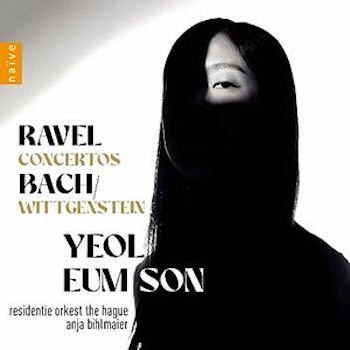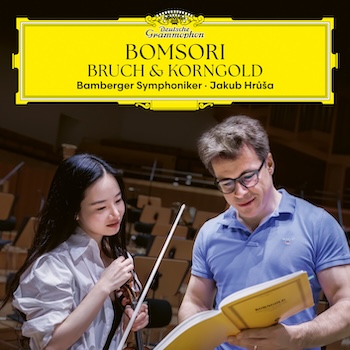Classical Music Album Reviews: Ravel/Bach and Bruch & Korngold Violin Concertos
By Jonathan Blumhofer
Pianist Yeol Eum Son is more than up to the demands of J.S. Bach and Maurice Ravel; violinist Bomsori brings exquisite balances and shimmering sonority to Bruch and Korngold.

J.S. Bach and Maurice Ravel aren’t composers one normally finds paired together. Yet pianist Yeol Eum Son has drawn just that connection on her new album, Ravel/Bach.
She makes the connection via Paul Wittgenstein, the Austrian pianist who lost his right arm in combat during World War I but continued his career as a left-handed artist. Among his postwar repertoire were the four arrangements of music by Bach that Son assays here, as well as Ravel’s Concerto for the Left Hand, which was written for him.
As such, there’s nothing really unfamiliar on this short release (the whole thing comes in just over the 50-minute mark). But it’s a fascinating concept, all the same, and Wittgenstein’s arrangements of the C-major Prelude from Book 1 of the Well-Tempered Clavier, the C-minor Prelude from the Suite for Beginners, “Gigue” from Partita No. 1, and the “Siciliene” from the Flute and Clavier Sonata are striking for their quiet virtuosity: if you didn’t know this was keyboard music played by just one hand, you’d never guess it from listening blind.
On the whole, Son is more than up to their demands — only the whirling “Gigue” feels reined in. Otherwise, both Preludes flow agreeably (the crisp C-minor installment is a particular pleasure to hear) and the “Siciliene” dances soberly.
The pianist is on similarly firm footing in the Concerto for the Left Hand, which is full of spirit and character. Its opening cadenza thunders with good textural and rhythmic clarity. Meantime, there’s a becoming warmth to the way the Andante unfolds and the cheeky Allegro swaggers.
Son’s partner in this work (as well as Ravel’s G-major Concerto, which fills out the disc) is the Residentie Orkest The Hague under the leadership of Anja Bihlmaier and, in both scores, they’re well-attuned to the sheer invention of Ravel’s style. Tempos move fluently and the music’s kaleidoscopic plays of color are painted with care.
That’s especially true in the G-major Concerto, where the outlandishly dreamy transition into the first-movement cadenza feels like it’s being made up on the spot. Here, too, exchanges between pianist and orchestra are crisp and balances clear. Best is the pairing’s account of the extraordinary Adagio, which unfolds as a weightless, hypnotic dance: pure, pristine, otherworldly.
 There are countless recordings of Max Bruch’s Violin Concerto No. 1 on the market. But it’s a safe bet that very few of them showcase that score’s orchestral accompaniment as brilliantly as does Deutsche Grammophon’s latest release of the piece with violinist Bomsori and the Bamberger Symphoniker led by Jakub Hrůša.
There are countless recordings of Max Bruch’s Violin Concerto No. 1 on the market. But it’s a safe bet that very few of them showcase that score’s orchestral accompaniment as brilliantly as does Deutsche Grammophon’s latest release of the piece with violinist Bomsori and the Bamberger Symphoniker led by Jakub Hrůša.
True, this isn’t the most exciting orchestral writing in the repertoire (or in Bruch, for that matter), and nobody’s likely to buy an album just to hear a subsidiary part, no matter how well-played. But the tonal concentration, rhythmic grounding, and textural clarity Hrůša draws from his forces perfectly complement Bomsori’s intense, poised contributions. The results are unobtrusively dramatic and fresh, especially in the gorgeous, quasi-operatic Adagio, which is conspicuously shapely and well directed.
The pairing’s account of Erich Wolfgang Korngold’s Violin Concerto proves just as bracing. Again, the Bamberger’s efforts are a model of exquisite balances and shimmering sonority. There’s a tremendous amount of activity going on in their part alone, yet the density of Korngold’s instrumentation never sounds too thick or overly busy.
Bomsori ably soars above and around all of it. At times in the outer movements, one misses the swashbuckling abandon of, say, Gil Shaham in her interpretation. But the violinist’s crisp rhythms, bright tone, and excellent intonation leave their marks; besides, the first-movement cadenza gets nice and feisty. Her take on the central Romance is exquisite: crystalline, singing, dreamlike.
Four more Korngold selections comprise the disc’s filler.
Violin-and-orchestra arrangements of Marietta’s Lied (“Glück, das mir verblieb”) from Die tote Stadt and the “Intermezzo” from Much Ado About Nothing continue to showcase this very fine partnership of soloist, conductor, and orchestra. Meanwhile, Bomsori and pianist Thomas Hoppe team up for a pair of transcriptions from Korngold’s Die stumme Serenade: a pure-toned “Schönste Nacht” and warmly urgent “Ohne Dich.”
Jonathan Blumhofer is a composer and violist who has been active in the greater Boston area since 2004. His music has received numerous awards and been performed by various ensembles, including the American Composers Orchestra, Kiev Philharmonic, Camerata Chicago, Xanthos Ensemble, and Juventas New Music Group. Since receiving his doctorate from Boston University in 2010, Jon has taught at Clark University, Worcester Polytechnic Institute, and online for the University of Phoenix, in addition to writing music criticism for the Worcester Telegram & Gazette.
Tagged: Bamberger Symphoniker, Bomsori, Deutsche Grammophon, Jakub Hrůša, Naïve
